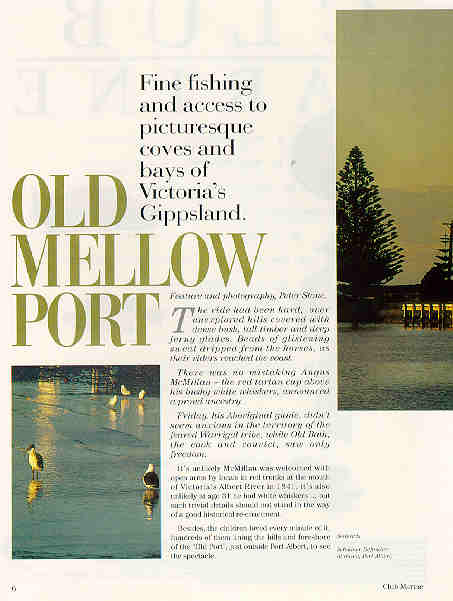|
YARRAM - PORT ALBERT AND DISTRICT South Gippsland
|
 |
|
YARRAM - PORT ALBERT AND DISTRICT South Gippsland
|
 |
 
Extract from manuscript prepared and published in Club Marine magazine, Vol 9, #3. Author: Peter Stone |
|
On 14th February 1991, precisely one hundred and fifty years after the arrival of McMillan's party of five, Port Albert and the citizens of Alberton Shire celebrated the birth of Gippsland. Over eight hundred children from ten schools in the district, many of them in period costume, gathered for a day of activities highlighted by the unvealing of a commemmorative plague by the Governor of Victoria Dr Davis McCaughey. Young Kurnai men from Morwell under the direction of Albert Mullet entranced youngsters with their traditional dance, many joining in with crouched posture as they imitated the Emu or enacted the hunt. There was no mistaking Angus McMillan - the red tartan cap forming a bridge over his bushy white whiskers announced a proud ancestry. The ride had been hard, over unexplored hills covered with dense bush, tall timbers and deep ferny glades. Beads of glistening sweat dripped from the horses, as anxious as their riders to have reached the southern coastline. Even Friday, his faithful aborigine guide, displayed less anxiety in the territory of the feared Warrigal tribe. Old Bath, cook and convict, saw only freedom.
It is doubtful that the Scottish explorer was greeted enthusiastically by local Aborigines when he arrived at the mouth of the Albert River in 1841. It is even more unlikely that the modesty of the indigenous locals be upheld with bright red trunks. But such trivial details should not stand in the way of an historical re-enactment. Besides, the kids loved every minute of it; hundreds of them lining the hills and foreshore of the 'Old Port' three kilometres from Port Albert, watching John Wood-Ingram, looking every bit the intrepid Scotsman, arrive on horseback. Kurnai warrior dancers brandished spears in mock aggression as a thousand pairs of excited eyes looked on in bewilderment. A shrill cheer rose from the young crowd as a longboat appeared from behind the mangroves, rowed with the vigor of those a century and a half before. The British flag was raised and a shattering "one gun" salute fired before passing around the obligatory cask of rum. The Kunai dancers seemed quite non-plussed. This would be a day to be remembered, a lesson in history - and pretty good fun as well. Two days later Port Albert was again the centre of attention with five thousand visitors attending a foreshore carnival. Captain Les Dick brought his 36m schooner Defender over from Launceston to join in the spirit of celebrations, taking visitors on afternoon cruises and hosting an evening meal each day of the week she was in port. Market stalls and free entertainment ensured a marvellous birthday party. The historical port had not seen so much activity since its heyday last century. The highlight of the day was an attempted robbery of the Bank of Victoria gold-shipment, successfully foiled by Mrs Mack and her well-aimed apple pie. The children, and their parents, loved it. With the celebrations over, Port Albert retired back to its sleepy ways. As an operational fishing port for the waters of Corner Inlet and Bass Strait, there is always some activity but generally it remains quietly reflectling on the days when it was the main port for central Gippsland, a vital link for the people and produce of the rich inland hills. At the entrance to the main channel, the boilers of the paddle steamer Clonmel may still be seen at low tide. She too had a significant role in the settlement of eastern Victoria. The 600-ton steamer left Sydney on 30th December 1840 on her second voyage to Port Phillip under command of Captain Tollervey. At around 3.00am on 2nd January 1841, the Clonmel grounded on a sandbank south of the present Port Albert. After an anxious night, all passengers and crew were safely landed on the narrow island that now bears the name of the ship. When finally the passengers and crew arrived at Port Phillip they told of the fertile narrow plain extending beyond the inlet toward northern hills. Encouraged by this report, and that of Count Strezlecki who had arrived in Melbourne on 19 May 1840 after crossing Gippsland from east to west, eight men formed the Gippsland Company to charter the 343-ton barque Singapore, Captain Hamilton. As they were leaving Melbourne on 6 February 1841, Angus McMillan was less than a week away from arriving at the eastern end of Corner Inlet. Neither party knew of the existence of the other. Had the Singapore sailed directly to the site of the wrecked Clonmel, the two groups may well have met. But the Gippsland Company lost several weeks in exploring the shallow waters of Corner Inlet, finding no suitable channel to enter. With expenses mounting and nothing to show for their efforts, Captain Hamilton sailed for the wreck of the Clonmel where they immediatrely noted a deep channel stretching inland. On March 9 the party landed nine horses and provisions, nameing the site Port Albert. A two-roomed cottage was erected as other members of the group under W.A.Brodribb headed north to explore the province, still unaware of McMillan's journey. They named the LaTrobe River and Lake Wellington, and commented on the magnificent fern valleys that now make up the Tarra-Bulga National Park north of Yarram. Had Brodribb and the other members of the Company been more observant they may have noticed the tall gum tree with the words ANGUS McMILLAN 14-2-1841 sliced into its trunk. McMillan had already been and gone. As overseer for land-owner Lachlan Macalister, McMillan penetrated deep into Victoria's south-east mountains, convinced that a track could be made to the sea. Refusing to abandon the rugged country, McMillan defied the authority of his boss and made a confident march south from Ensay (between Omeo and Bairnsdale) to reach Corner Inlet north east of Wilsons Promontory where he "supped the salt water in his Highland bonnet". Thus he became the first man to traverse the magnificent Gippsland ranges and has arguable claim, along with Count Strezlecki and Captain Tollervey, as being the founder of Gippsland. Whatever accolades history bestowes on the popular Highlander from Hebrides, his name will long be remembered for his courage, tenacity and sense of fair dealing with the local Aborigine tribes - or so history records. The determined immigrant epitomized the tough, determined settler that established the great Australian pastoral industry last century. But McMillan was also party to the tragedy of our early settlelement, having participate in the massacre of the indigenous people at Warrigal Creek. McMillan returned to Ensay and immediately arranged for a bullock team to assist in cutting a track down to Port Albert. Imagine his surprise when he arrived back at the mouth of the Albert River to find a cottage and a small company of men in tents where last he saw only blacks and kangaroos. Within months of the arrival of the Singapore, Port Albert was a hive of activity; huts and tents strewn along the narrow beach with over a hundred settlers planning their next move inland. McMillan was delighted that his expectations of a safe harbour had been proved. Cattle could now be driven south to Port Albert for despatch to Melbourne and Sydney. The Gippsland Company however was having more than their share of delays due to the bureaucracy of the Sydney government, caused in no small way by the conservative Governor Sir George Gipps. The Company planned to survey the land and sell off allotments but Surveyor-General Sir Thomas Mitchell refused permission for a Government Reserve and township. Without the advantages of a Special Survey, the Gippsland Company called for tenders for all stores and departed in November on the cutter Mary, leaving behind the desperate who could not afford passage. Assistant Surveyor Thomas Townsend completed his survey of the land between the Albert and Tarra rivers in December 1841. Townsend discovered a deep channel further south of the 'Old Port' at the Albert River entrance. Being more suited to shipping, the settlement moved to what we now know as Port Albert. The opening up of new pastoral lands resulted in the steady growth of Port Albert. The town thrived during the 1850's and 1860's as the major port for cattle and gold servicing eastern Victoria. The Bank of Victoria opened in 1856 when gold was discovered in Walhalla. By 1879 the railway from Melbourne had reached Sale. The port had served its purpose. |
|
|
|
|
|
|
|
|